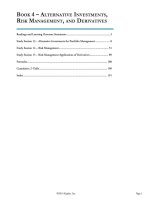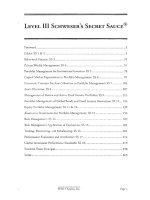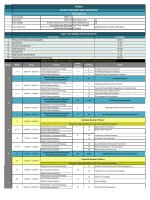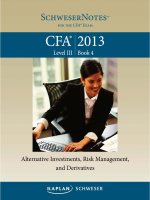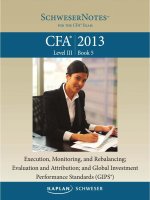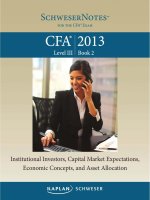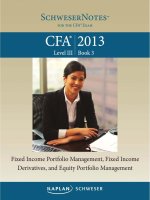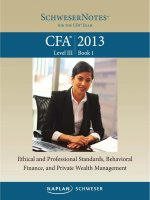2019 CFA level 3 schwesernotes book 1
Bạn đang xem bản rút gọn của tài liệu. Xem và tải ngay bản đầy đủ của tài liệu tại đây (3.68 MB, 196 trang )
Contents
1. Welcome to the 2019 Level III SchweserNotes™
2. Learning Outcome Statements
3. Study Session 1—Code of Ethics and Standards of Professional Conduct
1. Readings 1 & 2: CFA Institute Code of Ethics and Standards of Professional
Conduct Guidance for Standards I–VII
1. Exam Focus
2. Module 1.1: Code and Standards
3. Module 2.1: Guidance for Standards I(A) and I(B)
4. Module 2.2: Guidance for Standards I(C) and I(D)
5. Module 2.3: Guidance for Standard II
6. Module 2.4: Guidance for Standards III(A) and III(B)
7. Module 2.5: Guidance for Standards III(C), III(D), and III(E)
8. Module 2.6: Guidance for Standard IV
9. Module 2.7: Guidance for Standard V
10. Module 2.8: Guidance for Standard VI
11. Module 2.9: Guidance for Standard VII
12. Answer Key for Module Quizzes
4. Study Session 2—Ethical and Professional Standards in Practice
1. Reading 3: Application of the Code and Standards
1. Exam Focus
2. Module 3.1: Cases
3. Key Concepts
4. Answer Key for Module Quiz
2. Reading 4: Asset Manager Code of Professional Conduct
1. Exam Focus
2. Module 4.1: The Asset Manager Code
3. Key Concepts
4. Answer Key for Module Quiz
5. Study Session 3—The Asset Management Industry and Professionalism
1. Reading 5: Overview of the Asset Management Industry and Portfolio
Management
1. Exam Focus
2. Module 5.1: The Asset Management Industry
3. Module 5.2: The Portfolio Management Process and Investment
Governance
4. Key Concepts
5. Answer Key for Module Quiz
2. Reading 6: Professionalism in Investment Management
1. Exam Focus
2. Module 6.1: Establishing Trust, Expectations, and Challenges of
Investment Management Professionals
3. Key Concepts
6.
7.
8.
9.
10.
4. Answer Key for Module Quiz
Topic Assessment: Ethical and Professional Standards
Topic Assessment Answers: Ethical and Professional Standards
Study Session 4—Behavioral Finance
1. Reading 7: The Behavioral Finance Perspective
1. Exam Focus
2. Module 7.1: Intro: Traditional Finance vs. Behavioral Finance
3. Module 7.2: Utility Theory and Prospect Theory
4. Module 7.3: Implications
5. Key Concepts
6. Answer Key for Module Quizzes
2. Reading 8: The Behavioral Biases of Individuals
1. Exam Focus
2. Module 8.1: Cognitive Errors vs. Emotional Biases
3. Module 8.2: Emotional Biases
4. Key Concepts
5. Answer Key for Module Quiz
3. Reading 9: Behavioral Finance and Investment Processes
1. Exam Focus
2. Module 9.1: Classifying Investors
3. Module 9.2: Implications: Clients and Their Portfolios
4. Module 9.3: Implications: Other
5. Key Concepts
6. Answer Key for Module Quizzes
Topic Assessment: Behavioral Finance
Topic Assessment Answers: Behavioral Finance
List of pages
1.
2.
3.
4.
5.
6.
7.
8.
9.
10.
11.
12.
13.
14.
15.
16.
17.
18.
19.
20.
21.
22.
23.
24.
25.
26.
27.
28.
29.
30.
31.
32.
33.
34.
35.
36.
37.
38.
39.
40.
41.
42.
ix
x
xi
xii
xiii
xiv
xv
xvi
1
2
3
4
5
6
7
8
9
10
11
12
13
14
15
16
17
18
19
20
21
22
23
24
25
26
27
28
29
30
31
32
33
34
43.
44.
45.
46.
47.
48.
49.
50.
51.
52.
53.
54.
55.
56.
57.
58.
59.
60.
61.
62.
63.
64.
65.
66.
67.
68.
69.
70.
71.
72.
73.
74.
75.
76.
77.
78.
79.
80.
81.
82.
83.
84.
85.
86.
87.
88.
35
36
37
38
39
41
42
43
44
45
46
47
48
49
50
51
52
53
54
55
56
57
58
59
60
61
62
63
64
65
67
68
69
70
71
72
73
74
75
76
77
78
79
80
81
82
89.
90.
91.
92.
93.
94.
95.
96.
97.
98.
99.
100.
101.
102.
103.
104.
105.
106.
107.
108.
109.
110.
111.
112.
113.
114.
115.
116.
117.
118.
119.
120.
121.
122.
123.
124.
125.
126.
127.
128.
129.
130.
131.
132.
133.
134.
83
84
85
86
87
88
89
90
91
92
93
94
95
96
97
98
99
100
101
102
103
104
105
107
108
109
110
111
112
113
114
115
116
117
118
119
120
121
122
123
124
125
126
127
128
129
135.
136.
137.
138.
139.
140.
141.
142.
143.
144.
145.
146.
147.
148.
149.
150.
151.
152.
153.
154.
155.
156.
157.
158.
159.
160.
161.
162.
163.
164.
165.
166.
167.
168.
169.
170.
171.
172.
173.
174.
175.
176.
177.
178.
179.
180.
130
131
132
133
135
136
137
138
139
140
141
142
143
144
145
146
147
148
149
150
151
152
153
154
155
157
158
159
160
161
162
163
164
165
166
167
168
169
170
171
172
173
174
175
176
177
181.
182.
183.
184.
185.
186.
178
179
180
181
182
183
Kaplan Schweser’s Path to Success
Level III CFA® Exam
Welcome
As the head of Advanced Designations at Kaplan Schweser, I am pleased to
have the opportunity to help you prepare for the CFA® exam. Kaplan Schweser
has decades of experience in delivering the most effective CFA exam prep
products in the market and I know you will find them to be invaluable in your
studies.
Our products are designed to be an integrated study solution across print and
digital media to provide you the best learning experience, whether you are
studying with a physical book, online, or on your mobile device.
Our core product, the SchweserNotes™, addresses all of the Topics, Study
Sessions, Readings, and LOS in the CFA curriculum. Each reading in the
SchweserNotes has been broken into smaller, bite-sized modules with Module
Quizzes interspersed throughout to help you continually assess your
comprehension. Topic Assessments appear at the end of each Topic to help
you assess your knowledge of the material before you move on to the next
section.
All purchasers of the SchweserNotes receive online access to the Kaplan
Schweser online platform (our learning management system or LMS) at
www.Schweser.com. In the LMS, you will see a dashboard that tracks your
overall progress and performance and also includes an Activity Feed, which
provides structure and organization to the tasks required to prepare for the CFA
exam. You also have access to the SchweserNotes, Module Quizzes, and
Topic Assessments content as well as the Video Lectures (if purchased), which
contain a short video that complements each module in the SchweserNotes.
Look for the icons indicating where video content, Module Quizzes, and Topic
Assessments are available online. I strongly encourage you to enter your
Module Quiz and Topic Assessment answers online and use the dashboard to
track your progress and stay motivated.
Again, thank you for trusting Kaplan Schweser with your CFA exam preparation.
We’re here to help you throughout your journey to become a CFA charterholder.
Regards,
Derek Burkett
Derek Burkett, CFA, FRM, CAIA
Vice President (Advanced Designations)
CFA®
Contact us for questions about your study package, upgrading your package, purchasing
additional study materials, or for additional information:
888.325.5072 (U.S.) | +1 608.779.8327 (Int’l.)
| www.schweser.com/cfa
WELCOME TO THE 2019 LEVEL III
SCHWESERNOTES™
Thank you for trusting Kaplan Schweser to help you reach your goals. Our goal is to
increase your chances of correctly understanding the Level III material and passing the
exam. Unfortunately, candidates who assume Level III will be the same as Levels I and
II often do poorly. The solution is simple: work smarter, not harder. Smarter, as you will
see, does not mean just more of what you did at Levels I and II.
The Level III exam is half constructed response questions. The purpose of
constructed response questions is to test higher level thinking, judgment, and the
ability to organize a response. It differentiates how well candidates know the material.
A good constructed response question is one that a high percentage of candidates could
answer if shown answer choices A, B, and C but they are unable to answer the same
question in constructed response form. The exam is also highly integrated across
subjects. If you check the fine print from the CFA Institute, it will tell you that 85%–
90% is portfolio management. The other 10%–15% is ethics and guess what the focus
of ethics will be? Portfolio management.
Your previous study skills are useful but generally insufficient for Level III. Let me
stress three related things you will need to do. First, finish all the readings, classes,
and basic question practice a month before the exam. Integrate these three tasks
(class, reading, and related practice questions). At Levels I and II, most of you got most
of this done just before the exam. Second, spend the last month focused on taking,
reviewing, and retaking practice exams. Third, spend a lot of time writing. Buy three
new blue or black ink ball point pens and a wide-rule spiral notebook. Use them only
for writing out answers to practice questions. Wear them out before the exam. We’ll
return to these three requirements in our material, particularly in the classes.
Basic Preparation
The SchweserNotes™ are the base of our material. Five volumes cover all 18 Study
Sessions and every Learning Outcome Statement (LOS). There are examples, Key
Concepts, and Concept Checker questions for every reading. These SchweserNotes™
provide the base for your preparation and initial practice. Basic preparation should be
completed a month before the exam.
Study Planning
To be successful, you need a study plan. The simplest approach is to divide the
material so you read and practice each week, finishing the material and allowing a
month for intense review. Our classes are a good way to provide structure to your
plan. A good study plan includes the following.
Complete initial reading and question practice approximately a month before
the exam.
Initial reading of SchweserNotes™ and/or CFA readings.
Complete practice questions in our SchweserNotes™, discussion questions
in our ClassNotes, and SchweserPro™ QBank questions. Work questions
every week or time can get away from you.
Complete additional end-of-chapter questions in the CFA readings as time
allows.
Periodically review previous sessions.
Use your last month of study for final prep and performance.
Alternate your practice between a Schweser practice exam and an old CFA
morning exam. There is no specific number that results in passing.
However, the equivalent of seven full exams has been associated with
success at Level III. That number is higher than for Levels I and II.
What you do after taking a practice exam is equally important. When you
discover an area that appears more than once and you do poorly, review that
material, identify your mistakes, and correct them.
Use the last 7 to 10 days to retake practice exams to solidify skills (particularly
in constructed response) and verify that you can successfully perform what you
now know how to do.
We also have a range of other resources available. You can find more details at
Schweser.com; just sign in using the individual username and password you received
when you purchased the SchweserNotes™. I’ll highlight a few next.
Weekly Classes
Live Weekly Classroom Programs We offer weekly classroom programs around the
world. Please check Schweser.com for locations, dates, and availability. The classes can
save you time by directing you where to focus in each reading and provide additional
questions to work during and after class. The class material includes class discussion
questions so you can practice solving and writing exam-like questions with the
instructor’s guidance.
Both the live and online class candidates receive a weekly class letter that highlights
important issues, specific study hints, and possible pitfalls for that week’s material. It
regularly addresses that key stumbling block: the constructed response questions.
15-Week Online Classes Our Live Online Weekly Classes can be watched live and are
archived after each class for viewing and review at any time. Our online (and most of
our in-person) classes follow the study session order. Before the first class, we
recommend you read the SchweserNotes™ for Study Sessions 1 through 4. The
tentative class schedule is as follows.
Class #
Class #
1) How to Study Ethics, the Asset Management Industry and
Professionalism, and Behavioral Finance; SS1, 2, 3, and 4
9) Fixed Income; SS11
2) PM—Individuals; SS5
10) Fixed Income and Equity; SS12, 13
3) PM—Individuals; SS5, 6
11) Equity and Alternative
Investments; SS14, 15
4) PM—Individuals and Institutional; SS6, 7
12) Risk Management and Derivatives;
SS16, 17
5) PM Institutional and Applied Economics; SS7, 8
13) Derivatives; SS17
6) Applied Economics; SS8
14) Trading and Performance
Evaluation; SS18, 19
7) Asset Allocation 1; SS9
15) Performance Evaluation, How to
Study GIPS, and Exam Tips; SS19
8) Asset Allocation 2; SS10
Class time focuses on key issues in each topic area and applied problem solving of
questions. Candidates who wish for more background also have our Video Lectures
that provide more basic LOS-by-LOS coverage.
Late Season Preparation
The material discussed above is intended for basic preparation and initial practice. The
last month should focus on practice exams with intense review, practice, and
performance.
Multi-Day Review Workshops These pull together the material and focus on problem
solving with additional questions. Our most complete late-season review courses are
residence programs in Windsor, Ontario (WindsorWeek), Dallas/Fort Worth, Texas
(DFW five-day program), and the New York five-day program. We also offer three-day
Exam Workshops in many cities (and online) that combine curriculum review and
hands-on practice with hundreds of questions plus problem-solving techniques. Please
check Schweser.com for locations, dates, and availability.
Mock Exam and Multimedia Tutorial The Schweser Mock Exam is offered live in
many cities around the world and online as well. The optional Multimedia Tutorial
provides extended explanation and topic tutorials to get you exam-ready in areas where
you missed questions on the Mock Exam. Please check Schweser.com for locations,
dates, and availability.
Practice Exams We have two volumes with two, full six-hour exams in each. In
addition to the answers, we discuss how points are allocated for each constructed
response question.
Past Exam Questions The CFA old exam questions for the morning session of the
exam are released and are part of your final review. In the Resource Library, we provide
videos and work through how to solve each past question. But remember to work smart;
the old exams are only a sample of what may be asked, so combine them with the
Schweser practice exams.
Schweser’s Secret Sauce® One brief volume highlights key material. It will not replace
the full SchweserNotes™ and classes but it is a great review tool for the last month.
How to Succeed
There are no shortcuts. Count on the CFA Institute to think of test angles they have not
shown before. Begin your study early and with a plan. Read the SchweserNotes™.
Attend a live or online class each week and work practice questions. Take quizzes often
using SchweserPro™ QBank. At the end of each topic area, take the Self-Test to check
your progress. Review previous topics periodically. Use the CFA texts to supplement
weak areas and for additional end-of-chapter questions. Finish this initial study a month
before the exam so you have sufficient time to take, review, and retake Practice Exams.
I would like to thank Kurt Schuldes, CFA, CAIA, and Level III content specialist, for
his contributions to the 2019 Level III SchweserNotes™ for the CFA Exam.
Time to hit the books,
David Hetherington
David Hetherington, CFA
VP and Level III CFA manager
Kaplan Schweser
专业提供CFA/FRM/AQF视频课程资料 微信:fcayyh
Exam Topic Weights
The CFA Institute has indicated that these are guidelines only and not specific
rules they will follow. They are also subject to change. At Level III, all topics except
ethics can be integrated into portfolio management questions. The guidelines
provide a rough indication of how to allocate your initial study time. The most accurate
interpretation of Level III is that it is 100% portfolio management.
Exam Format
The morning and afternoon of the exam use different exam formats. Each is three hours
long. Both have a maximum score of 180 points out of the total maximum exam score
of 360 points.
The morning exam is three hours of constructed response questions. Usually there are 8
to 12 questions with each question having multiple parts. For each question part, you
will be directed to answer on a specific page in the exam book. If you do not answer
where directed, you will receive no score for that question part. The morning is usually
heavily devoted to portfolio management questions. Every question will state a
specified number of minutes. The minutes are the max score you can receive for that
question. Most questions do not have one specific right answer but a range of acceptable
versus unacceptable answers. Partial credit for an answer is normal.
The afternoon is the multiple choice, item set style of question from Level II. It’s three
hours for 10 six-question vignettes. Ten times six is 60 individual questions and each
has a score of three points. For each question there is one correct answer: A, B, or C.
LEARNING OUTCOME STATEMENTS (LOS)
STUDY SESSION 1
The topical coverage corresponds with the following CFA Institute assigned reading:
1. & 2. CFA Institute Code of Ethics and Standards of Professional
Conduct Guidance for Standards I–VII
The candidate should be able to:
1.a. describe the structure of the CFA Institute Professional Conduct Program and the
disciplinary review process for the enforcement of the CFA Institute Code of
Ethics and Standards of Professional Conduct. (page 2)
1.b. explain the ethical responsibilities required by the Code and Standards, including
the sub-sections of each standard. (page 3)
2.a. demonstrate a thorough knowledge of the CFA Institute Code of Ethics and
Standards of Professional Conduct by interpreting the Code and Standards in
various situations involving issues of professional integrity. (page 8)
2.b. recommend practices and procedures designed to prevent violations of the Code
and Standards. (page 8)
STUDY SESSION 2
The topical coverage corresponds with the following CFA Institute assigned reading:
3. Application of the Code and Standards
The candidate should be able to:
a. evaluate professional conduct and formulate an appropriate response to actions that
violate the CFA Institute Code of Ethics and Standards of Professional Conduct.
(page 41)
b. formulate appropriate policy and procedural changes needed to assure compliance
with the Code and Standards. (page 41)
The topical coverage corresponds with the following CFA Institute assigned reading:
4. Asset Manager Code of Professional Conduct
The candidate should be able to:
a. explain the purpose of the Asset Manager Code and the benefits that may accrue to
a firm that adopts the Code. (page 55)
b. explain the ethical and professional responsibilities required by the six General
Principles of Conduct of the Asset Manager Code. (page 56)
c. determine whether an asset manager’s practices and procedures are consistent with
the Asset Manager Code. (page 56)
d. recommend practices and procedures designed to prevent violations of the Asset
Manager Code. (page 56)
STUDY SESSION 3
The topical coverage corresponds with the following CFA Institute assigned reading:
5. Overview of the Asset Management Industry and Portfolio
Management
The candidate should be able to:
a. describe the structure of the asset management industry. (page 68)
b. discuss a portfolio management process that supports achieving asset owners’
objectives. (page 72)
c. discuss the elements of effective investment governance. (page 73)
The topical coverage corresponds with the following CFA Institute assigned reading:
6. Professionalism in Investment Management
The candidate should be able to:
a. describe professions and how they establish trust. (page 79)
b. explain professionalism in investment management. (page 80)
c. describe expectations of and challenges for investment management professionals.
(page 81)
STUDY SESSION 4
The topical coverage corresponds with the following CFA Institute assigned reading:
7. The Behavioral Finance Perspective
The candidate should be able to:
a. contrast traditional and behavioral finance perspectives on investor decision
making. (page 107)
b. contrast expected utility and prospect theories of investment decision making.
(page 112)
c. discuss the effect that cognitive limitations and bounded rationality may have on
investment decision making. (page 115)
d. compare traditional and behavioral finance perspectives on portfolio construction
and the behavior of capital markets. (page 121)
The topical coverage corresponds with the following CFA Institute assigned reading:
8. The Behavioral Biases of Individuals
The candidate should be able to:
a. distinguish between cognitive errors and emotional biases. (page 135)
b. discuss commonly recognized behavioral biases and their implications for financial
decision making. (page 136)
c. identify and evaluate an individual’s behavioral biases. (page 136)
d. evaluate how behavioral biases affect investment policy and asset allocation
decisions and recommend approaches to mitigate their effects. (page 136)
The topical coverage corresponds with the following CFA Institute assigned reading:
9. Behavioral Finance and Investment Processes
The candidate should be able to:
a. explain the uses and limitations of classifying investors into personality types.
(page 157)
b. discuss how behavioral factors affect adviser–client interactions. (page 162)
c. discuss how behavioral factors influence portfolio construction. (page 163)
d. explain how behavioral finance can be applied to the process of portfolio
construction. (page 165)
e. discuss how behavioral factors affect analyst forecasts and recommend remedial
actions for analyst biases. (page 166)
f. discuss how behavioral factors affect investment committee decision making and
recommend techniques for mitigating their effects. (page 170)
g. describe how behavioral biases of investors can lead to market characteristics that
may not be explained by traditional finance. (page 171)
The following is a review of the Code of Ethics and Standards of Professional Conduct principles designed
to address the learning outcome statements set forth by CFA Institute. Cross-Reference to CFA Institute
Assigned Readings #1 and #2.
READINGS 1 & 2: CFA INSTITUTE CODE
OF ETHICS AND STANDARDS OF
PROFESSIONAL CONDUCT GUIDANCE
FOR STANDARDS I–VII
Study Session 1
EXAM FOCUS
Ethics will most likely be 10%–15% of the exam with two or three item set questions.
While the CFA Institute has never specifically said they will not use constructed
responses for ethics, they have not done so for over 10 years. The content and what you
need to know will be the same regardless of the question format.
Level III questions tend to focus on compliance, portfolio management issues, and
questions on the Asset Manager Code. Prepare properly and ethics can be an easier
section of the exam. That is a big advantage when you move to the questions in other
topic areas.
Just like Level I and Level II, ethics requires that you know the principles and be able to
apply them to specific situations to make the expected decision. Some ethics questions
can be vague with unclear facts so be prepared to make a “best guess” on a few of the
questions. As you read the material, pay particular attention to the numerous examples
(the application). As soon as you read, work the Schweser and CFA end of chapter
questions. Reading principles without practice questions for application or vice versa
will not be sufficient. You need both.
Be prepared and make this an easier part of the exam.
MODULE 1.1: CODE AND STANDARDS
LOS 1.a: Describe the structure of the CFA Institute Professional
Conduct Program and the disciplinary review process for the
enforcement of the CFA Institute Code of Ethics and Standards of
Professional Conduct.
Video covering
this content is
available online.
CFA® Program Curriculum, Volume 1, page 9
The CFA Institute Professional Conduct Program is covered by the CFA Institute
Bylaws and the Rules of Procedure for Proceedings Related to Professional Conduct.
The Program is based on the principles of fairness of the process to members and
candidates and maintaining the confidentiality of the proceedings. The Disciplinary
Review Committee of the CFA Institute Board of Governors has overall responsibility
for the Professional Conduct Program and enforcement of the Code and Standards.
The CFA Institute Professional Conduct staff conducts inquiries related to professional
conduct. Several circumstances can prompt such an inquiry:
1. Self-disclosure by members or candidates on their annual Professional Conduct
Statements of involvement in civil litigation or a criminal investigation, or that the
member or candidate is the subject of a written complaint.
2. Written complaints about a member or candidate’s professional conduct that are
received by the Professional Conduct staff.
3. Evidence of misconduct by a member or candidate that the Professional Conduct
staff received through public sources, such as a media article or broadcast.
4. A report by a CFA exam proctor of a possible violation during the examination.
5. Analysis of exam materials and monitoring of social media by CFA Institute.
Once an inquiry has begun, the Professional Conduct staff may request (in writing) an
explanation from the subject member or candidate and may: (1) interview the subject
member or candidate, (2) interview the complainant or other third parties, and/or (3)
collect documents and records relevant to the investigation.
The Professional Conduct staff may decide: (1) that no disciplinary sanctions are
appropriate, (2) to issue a cautionary letter, or (3) to discipline the member or candidate.
In a case where the Professional Conduct staff finds a violation has occurred and
proposes a disciplinary sanction, the member or candidate may accept or reject the
sanction. If the member or candidate chooses to reject the sanction, the matter will be
referred to a disciplinary review panel of CFA Institute members for a hearing.
Sanctions imposed may include condemnation by the member’s peers or suspension of
candidate’s continued participation in the CFA Program.
LOS 1.b: Explain the ethical responsibilities required by the Code and Standards,
including the sub-sections of each standard.
CFA® Program Curriculum, Volume 1, page 15
CODE OF ETHICS
Members of CFA Institute [including Chartered Financial Analyst® (CFA®)
charterholders] and candidates for the CFA designation (“Members and Candidates”)
must:1
Act with integrity, competence, diligence, respect, and in an ethical manner with
the public, clients, prospective clients, employers, employees, colleagues in the
investment profession, and other participants in the global capital markets.
Place the integrity of the investment profession and the interests of clients above
their own personal interests.
Use reasonable care and exercise independent professional judgment when
conducting investment analysis, making investment recommendations, taking
investment actions, and engaging in other professional activities.
Practice and encourage others to practice in a professional and ethical manner that
will reflect credit on themselves and the profession.
Promote the integrity and viability of the global capital markets for the ultimate
benefit of society.
Maintain and improve their professional competence and strive to maintain and
improve the competence of other investment professionals.
THE STANDARDS OF PROFESSIONAL CONDUCT
I.
II.
III.
IV.
V.
VI.
VII.
Professionalism
Integrity of Capital Markets
Duties to Clients
Duties to Employers
Investment Analysis, Recommendations, and Actions
Conflicts of Interest
Responsibilities as a CFA Institute Member or CFA Candidate
STANDARDS OF PROFESSIONAL CONDUCT2
I. PROFESSIONALISM
A. Knowledge of the Law. Members and Candidates must understand and
comply with all applicable laws, rules, and regulations (including the CFA
Institute Code of Ethics and Standards of Professional Conduct) of any
government, regulatory organization, licensing agency, or professional
association governing their professional activities. In the event of conflict,
Members and Candidates must comply with the more strict law, rule, or
regulation. Members and Candidates must not knowingly participate or
assist in any violation of laws, rules, or regulations and must disassociate
themselves from any such violation.
B. Independence and Objectivity. Members and Candidates must use
reasonable care and judgment to achieve and maintain independence and
objectivity in their professional activities. Members and Candidates must
not offer, solicit, or accept any gift, benefit, compensation, or consideration
that reasonably could be expected to compromise their own or another’s
independence and objectivity.
C. Misrepresentation. Members and Candidates must not knowingly make
any misrepresentations relating to investment analysis, recommendations,
actions, or other professional activities.
D. Misconduct. Members and Candidates must not engage in any professional
conduct involving dishonesty, fraud, or deceit or commit any act that
reflects adversely on their professional reputation, integrity, or competence.
II. INTEGRITY OF CAPITAL MARKETS
A. Material Nonpublic Information. Members and Candidates who possess
material nonpublic information that could affect the value of an investment
must not act or cause others to act on the information.
B. Market Manipulation. Members and Candidates must not engage in
practices that distort prices or artificially inflate trading volume with the
intent to mislead market participants.
III. DUTIES TO CLIENTS
A. Loyalty, Prudence, and Care. Members and Candidates have a duty of
loyalty to their clients and must act with reasonable care and exercise
prudent judgment. Members and Candidates must act for the benefit of their
clients and place their clients’ interests before their employer’s or their own
interests.
B. Fair Dealing. Members and Candidates must deal fairly and objectively
with all clients when providing investment analysis, making investment
recommendations, taking investment action, or engaging in other
professional activities.
C. Suitability.
1. When Members and Candidates are in an advisory relationship with a
client, they must:
a. Make a reasonable inquiry into a client’s or prospective clients’
investment experience, risk and return objectives, and financial
constraints prior to making any investment recommendation or
taking investment action and must reassess and update this
information regularly.
b. Determine that an investment is suitable to the client’s financial
situation and consistent with the client’s written objectives,
mandates, and constraints before making an investment
recommendation or taking investment action.
c. Judge the suitability of investments in the context of the client’s
total portfolio.
2. When Members and Candidates are responsible for managing a
portfolio to a specific mandate, strategy, or style, they must make only
investment recommendations or take investment actions that are
consistent with the stated objectives and constraints of the portfolio.
D. Performance Presentation. When communicating investment performance
information, Members or Candidates must make reasonable efforts to ensure
that it is fair, accurate, and complete.
E. Preservation of Confidentiality. Members and Candidates must keep
information about current, former, and prospective clients confidential
unless:
1. The information concerns illegal activities on the part of the client or
prospective client,
2. Disclosure is required by law, or
3. The client or prospective client permits disclosure of the information.
IV. DUTIES TO EMPLOYERS
A. Loyalty. In matters related to their employment, Members and Candidates
must act for the benefit of their employer and not deprive their employer of
the advantage of their skills and abilities, divulge confidential information,
or otherwise cause harm to their employer.
B. Additional Compensation Arrangements. Members and Candidates must
not accept gifts, benefits, compensation, or consideration that competes
with, or might reasonably be expected to create a conflict of interest with,
their employer’s interest unless they obtain written consent from all parties
involved.
C. Responsibilities of Supervisors. Members and Candidates must make
reasonable efforts to ensure that anyone subject to their supervision or
authority complies with applicable laws, rules, regulations, and the Code
and Standards.
V. INVESTMENT ANALYSIS, RECOMMENDATIONS, AND ACTIONS
A. Diligence and Reasonable Basis. Members and Candidates must:
1. Exercise diligence, independence, and thoroughness in analyzing
investments, making investment recommendations, and taking
investment actions.
2. Have a reasonable and adequate basis, supported by appropriate
research and investigation, for any investment analysis,
recommendation, or action.
B. Communication with Clients and Prospective Clients. Members and
Candidates must:
1. Disclose to clients and prospective clients the basic format and general
principles of the investment processes used to analyze investments,
select securities, and construct portfolios and must promptly disclose
any changes that might materially affect those processes.
2. Disclose to clients and prospective clients significant limitations and
risks associated with the investment process.
3. Use reasonable judgment in identifying which factors are important to
their investment analyses, recommendations, or actions and include
those factors in communications with clients and prospective clients.
